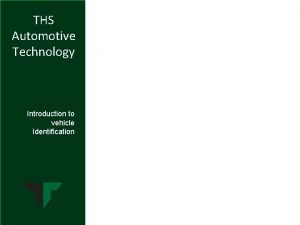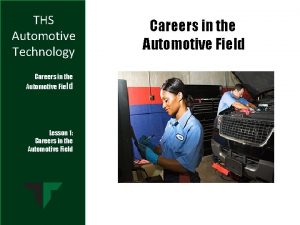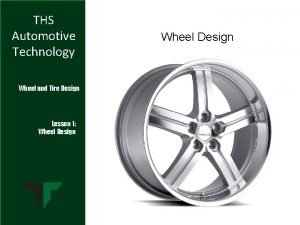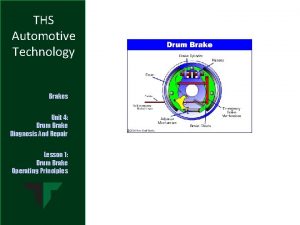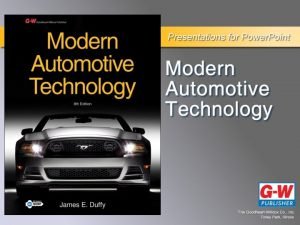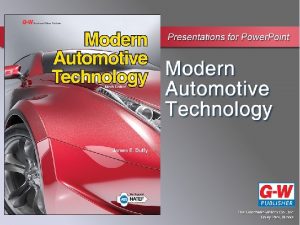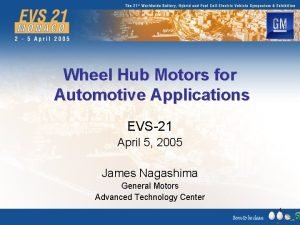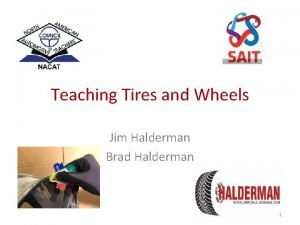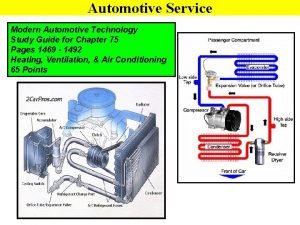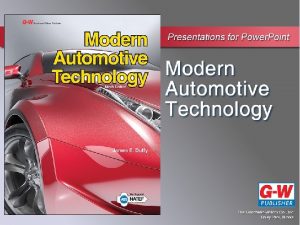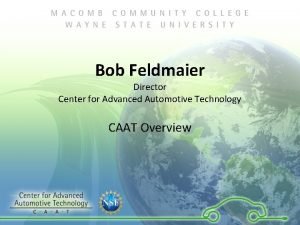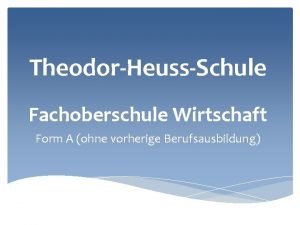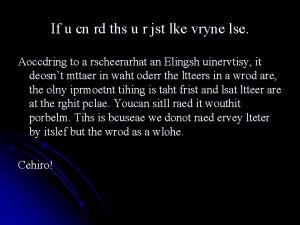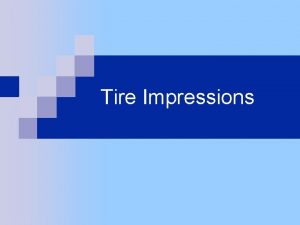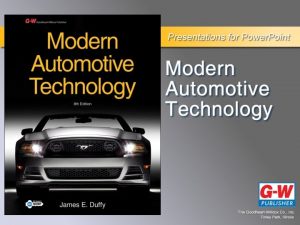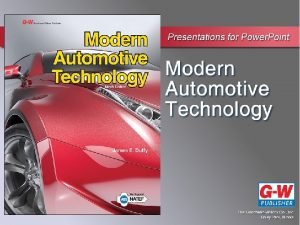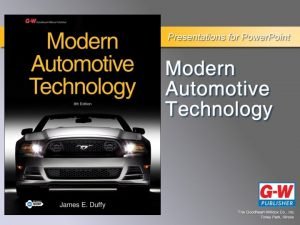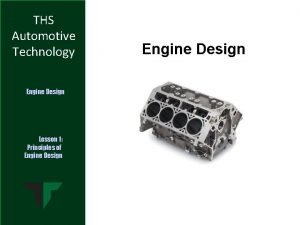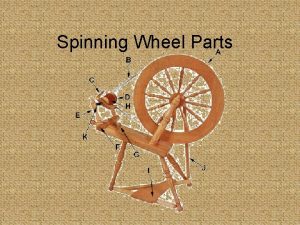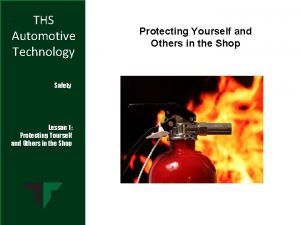THS Automotive Technology Wheel and Tire Design Lesson



















- Slides: 19

THS Automotive Technology Wheel and Tire Design Lesson 1: Wheel Design

THS Automotive Technology Basic wheel construction • Wheels are made from stamped steel or cast or forged aluminum or alloys. • A wheel consists of the following basic parts. Wheel and Tire Design Holes for the mounting wheel lugs Rim Hole for a valve stem Lesson 1: Wheel Design Dropped center section Bead section

THS Automotive Technology Wheel and Tire Design Lesson 1: Wheel Design Basic wheel construction • The wheel usually has between four and six mounting holes that connect the wheel to the wheel hub of the vehicle. • Wheel sizes are designated by the diameter of the wheel from bead to bead and also by the width of the wheel between the rim flanges. Common wheel diameters for passenger vehicles are 12 in, 13 in, 15 in, and 16 in.

THS Automotive Technology Wheel and Tire Design Lesson 1: Wheel Design Basic wheel construction • Many wheels have safety rims. The rims have a safety ridge near the lip of the wheel ridge that helps keep the tire from entering the inner depressed part of the wheel. This lip helps to prevent the bead from unseating if the vehicle corners hard or if the tire goes flat while the vehicle is moving.

THS Automotive Technology Basic wheel construction • The inner depressed area allows for tire bead clearance; a tire machine is then used to stretch the other bead over the wheel ridge. • Valve stems Wheel and Tire Design Valve stems are mounted into a wheel. This enables the addition or removal of air from the tire. Lesson 1: Wheel Design If the valve stems are made from rubber, they snap into the hole.

THS Automotive Technology Basic wheel construction Other valve stems are made from metal that are held in place with a nut. The valve core is located within the stem, allowing air to enter when inflating. Wheel and Tire Design A small return spring keeps a tight seal around the valve core. • Wheel offset Lesson 1: Wheel Design Factory-installed wheels are designed with proper clearance for brake and suspension components. Wheels are also designed to distribute the vehicle load evenly on the wheel bearings.

THS Automotive Technology Wheel and Tire Design Lesson 1: Wheel Design Basic wheel construction Offset is the distance in inches between the vertical centerline of the rim and the mounting flange of the wheel center. • If the centerline of the rim is inboard to the mounting flange of the wheel center, it is considered a positive offset. • If the centerline of the rim is outboard to the mounting flange of the wheel center, it is considered a negative offset.

THS Automotive Technology Wheel and Tire Design Lesson 1: Wheel Design Types of wheel designs • Stamped steel wheels One type of automotive wheel design is made from stamped steel. The wheel consists of two pieces: the center and the rim. • The center section is riveted or spot welded to the rim (the outer portion). • The mounting holes are tapered to match the tapered wheel nuts (lug nuts). The tapering helps to center the wheel on the wheel studs. • These wheels are commonly dressed out with a hubcap.

THS Automotive Technology Wheel and Tire Design Types of wheel designs • Cast and forged wheels Many wheels today use lighter materials than steel such as aluminum and aluminum alloys. Lighter vehicles have better fuel efficiency. Aluminum wheels usually have a high-quality finish, so the hubcaps are not normally used. Lesson 1: Wheel Design The term "mag wheels" is commonly given to wheels made from magnesium or other alloys. • Wheels with tire pressure sensors In an effort to reduce accidents due to underinflated tires, the National Highway Traffic Safety Administration has issued legislation requiring all new passenger vehicles to be equipped with tire pressure monitoring systems.

THS Automotive Technology Wheel and Tire Design Types of wheel designs Many tire pressure monitoring systems use batteryoperated sensors that send radio signals to a receiver module. The basic operation of the system is as follows. • A tire pressure sensor, mounted on the rim and in the valve stem hole of all four wheels on the vehicle and the spare, senses tire pressure and temperature. Lesson 1: Wheel Design • The sensors send the data about each tire to a receiver module. If the tire pressure goes below or above a certain level that is programmed in the system, the module sends a signal to a display on the dashboard to warn the driver.

THS Automotive Technology Types of wheel designs Basic components • Tire pressure sensors, which are composed of a transmitter, battery, valve stem with core and cap, mounting nut, and sealing grommet Wheel and Tire Design Lesson 1: Wheel Design • Electronic receiver module with dashboard console for digital display • Special magnet tool for programming the tire pressure sensors

THS Automotive Technology Types of wheel designs The following are the advantages of maintaining the proper tire pressure. • Enhanced safety due to fewer tire blowouts and improved vehicle handling Wheel and Tire Design • Better fuel economy • Longer tire life Lesson 1: Wheel Design

THS Automotive Technology Wheel and Tire Design Lesson 1: Wheel Design Wheel maintenance • Wheel offset When replacing a wheel or installing an aftermarket wheel, use a wheel that has the same offset (positive or negative) as the original. Many aftermarket wheels have an offset that is different from the original factory wheel. • A difference in the offset can affect wheel alignment, vehicle handling, and tire wear. • A different offset could also affect weight distribution on the spindle and wheel bearings. This causes premature failure of these components.

THS Automotive Technology Wheel and Tire Design Lesson 1: Wheel Design Wheel maintenance • Wheel runout (See Unit 13, Lesson 3 for more information. ) Always replace damaged wheels. Wheels can become damaged from accidents, age (rust), and hitting large potholes or curbs. • Rims are measured for runout to determine if the wheel is out-of-round. Wheels can have lateral or radial runout. • Lateral or radial runout is measured with a dial indicator. • If the wheel runout exceeds the manufacturer's specifications, replace the wheel. • Excessive wheel runout may cause the vehicle to shimmy or vibrate.

THS Automotive Technology Wheel and Tire Design Wheel maintenance • Torque specifications It is important to torque all wheels (steel or alloy) to the proper specifications for the following reasons. • If the lug nuts are not tight enough, the wheel may fall off while it is driven. • The lug nuts may vibrate loose. Once they are loose, the wheels can shear the studs off of the hub. Lesson 1: Wheel Design • If the lug nuts are too tight, the disc brake rotor may become distorted or warped. • If the lug nuts are too tight, the driver may not be able to loosen the lug nuts with a hand lug wrench in an emergency. • If the wheel studs or nuts become stripped, premature failure occurs. NOTE: Lug nut torque specifications typically range from 80 ft-lb (foot-pounds) to 120 ft-lb, but always check the manufacturer's specifications.

THS Automotive Technology Wheel and Tire Design Lesson 1: Wheel Design Wheel maintenance Tighten the lug nuts in the correct sequence. Failure to do so could result in bending or warping the wheel, brake drum, or brake rotor.

THS Automotive Technology Wheel maintenance When tightening the lug nuts, ensure that the taper of the lug nut is toward the wheel. Wheel and Tire Design Lesson 1: Wheel Design • Snug the lug nut up to the wheel. • Then tighten in the correct sequence and to the correct specifications with a torque wrench (manually) or with a torque stick (using pneumatic tools).

THS Automotive Technology Wheel and Tire Design Lesson 1: Wheel Design Wheel maintenance Antitheft lug nuts are used on many cars today. • Usually, one antitheft lug nut is used per wheel to prevent someone from stealing wheels and tires from a vehicle. • The manufacturer supplies a special lug nut key that loosens and tightens the antitheft lug nut.

THS Automotive Technology Wheel and Tire Design Lesson 1: Wheel Design Wheel maintenance Torque sticks are a set (usually four to eight pieces) of color-coded, long-shafted sockets. The shafts have a different diameter. • They work in combination with a pneumatic (impact) wrench to install lug nuts. • The thicker the shaft's diameter, the higher the torque provided. • The manufacturer of the torque sticks provides an application chart for most vehicles.
 Ths automotive
Ths automotive Ths automotive
Ths automotive Wheel tire design
Wheel tire design Ths automotive
Ths automotive Tire wheel and wheel bearing fundamentals
Tire wheel and wheel bearing fundamentals Chapter 73 tire wheel and wheel bearing fundamentals
Chapter 73 tire wheel and wheel bearing fundamentals Wheel hub motors for automotive applications
Wheel hub motors for automotive applications Automotive technology sixth edition
Automotive technology sixth edition China automotive technology and research center
China automotive technology and research center Tire safety presentation
Tire safety presentation What is tire rotation
What is tire rotation Modern automotive technology answer key
Modern automotive technology answer key Automotive technology sixth edition
Automotive technology sixth edition Automotive technology chapter 51 answers
Automotive technology chapter 51 answers Mechanical technology automotive grade 11
Mechanical technology automotive grade 11 Autocaat
Autocaat Rivet split pin dublin
Rivet split pin dublin Ths-ldk
Ths-ldk If u cn rd ths u cn gt a gd jb w hi pa!
If u cn rd ths u cn gt a gd jb w hi pa! Ths 100
Ths 100
